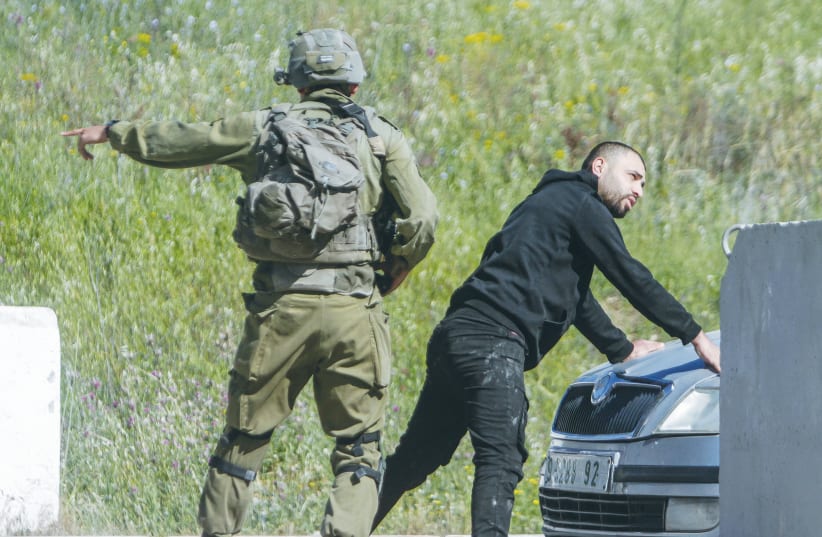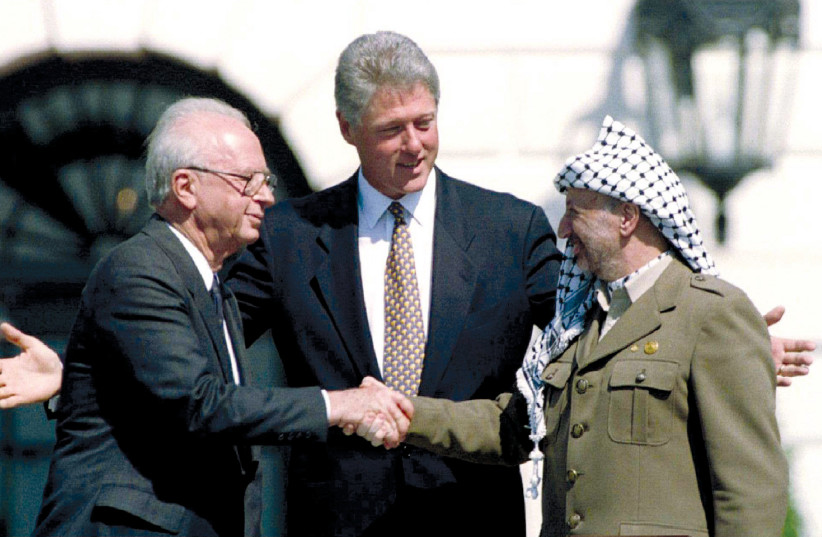Jamma’in, Jelazoun, El-Bireh, Dura, Khursa, Fawwar and Ein as-Sultan: What do these towns have in common?
In Jamma’in, near Nablus, the Israeli security forces arrested a fugitive Palestinian Arab terrorist last week. In Jelazoun and nearby El-Bireh, they captured four more. In addition, four terrorists were apprehended in Dura, Khursa and Fawwar, and another in Ein as-Sultan. Many weapons were also seized, the Israeli Army spokesman said.
All the towns are ruled by the PA
What these seven towns have in common is that they are ruled by the Palestinian Authority. And they are all teeming with terrorists, weapons depots and hideouts.
This is the great untold story of the Arab-Israeli conflict. The part that is never reported on CNN or in The Washington Post – the network of terrorist havens that operate freely under the auspices of the Palestinian Authority and its American-trained and American-armed security forces.
When then-prime minister Yitzhak Rabin agreed to the Oslo II accord, giving the Palestinian Authority control over the areas where 98% of the Palestinian Arabs live, he knew that Israel would be taking a big risk. It would be turning over the fight against terrorism to the PA. It would be putting Israel’s security in the hands of Yasser Arafat (and, later, his successor, Mahmoud Abbas).
So, Rabin was sure to include in the accords a list of specific actions that the PA is required to take to ensure an end to terrorism against Israel:
• The PA must “arrest and prosecute individuals who are suspected of perpetrating acts of violence and terror” (Annex I, Article II, 1-d).
• The PA must “apprehend, investigate and prosecute perpetrators and all other persons directly or indirectly involved in acts of terrorism, violence and incitement.” (Annex I, Article II, 3-c).
• The PA is responsible for “combating terrorism and violence, and preventing incitement to violence” (Annex I, Article IV, 1-f).
To carry out these actions, Rabin authorized the creation of a 12,000-man PA security force. The Clinton administration offered to train and arm it.
Over the years, that force gradually evolved into a de-facto army, numbering 30,000 men. A recent report from the left-leaning Washington Institute on Near East Policy analyzed the record of the PA security forces.
“By late 1998,” according to the report, “the PA security services, as they were then known, had in almost every regard violated the letter of the agreements reached with Israel… [The PA became] one of the most heavily policed territories in the world.”
The PA was supposed to show Israel lists of those whom it was hiring for the forces, so Israel could veto known terrorists. Instead, “Israeli government officials were also aware that the PA was not submitting complete lists of this security personnel, to obfuscate the total number under arms and to bypass Israeli background checks for those with terrorist backgrounds.”
The report continued: “Similarly, a proliferation of weapons was occurring, both in quantity and quality, well beyond that stipulated in Oslo II. By one estimate, there were at least 40,000 more weapons than allowed in the agreement, including RPGs, mortars, mines, grenade launchers, and sniper rifles; also, being developed was a small-scale indigenous manufacturing capacity for hand grenades and other ammunition.”
What this means is that the PA is fully capable of arresting terrorists in towns such as Jamma’in, Jalazone, El-Bireh, Dura, Khursa, Fawwar, Ein as-Sultan. The PA has governed those towns for the past 28 years. The PA knows the terrain better than the Israelis; and its intelligence there is better than Israel’s.
Yet, nearly three decades later, those towns are still filled with terrorists, forcing Israel to send its soldiers there to capture them. Which is why Israeli soldiers briefly entered Jamma’in, Jalazone, El-Bireh, Dura, Khursa, Fawwar, and Ein as-Sultan last week.
That is the troubling reality of life in the Palestinian Authority-occupied areas today. There’s no Israeli “occupation.” There are no Israeli troops stationed there, no Israeli military governor giving orders. Just terrorists running free, a PA that ignores its Oslo obligations to arrest them, and an international community that chooses to look away.
The writer is an attorney, and the father of Alisa Flatow, who was murdered in an Iranian-sponsored Palestinian terrorist attack in 1995. He is author of A Father’s Story: My Fight for Justice Against Iranian Terror.

